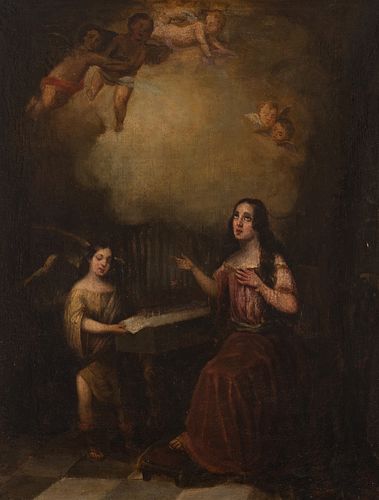Sevillian school; 1840-1830. "Repentant Magdalena". Oil on canvas.
Lot 57
About Seller
Setdart Auction House
Carrer Aragó 346
Barcelona
Spain
Setdart Subastas was born in 2004 and is currently the first online art auction in Spain with solidity, prestige and reliability guaranteed by our more than 60,000 users. Setdart has a young, dynamic and enterprising team ready to successfully manage the purchase and sale of art works through custom...Read more
Estimate:
EUR€1,500 - EUR€2,000
$1,612.90 - $2,150.54
Absentee vs Live bid
Two ways to bid:
- Leave a max absentee bid and the platform will bid on your behalf up to your maximum bid during the live auction.
- Bid live during the auction and your bids will be submitted real-time to the auctioneer.
Bid Increments
| Price | Bid Increment |
|---|---|
| EUR€0 | EUR€10 |
| EUR€200 | EUR€25 |
| EUR€500 | EUR€50 |
| EUR€1,000 | EUR€100 |
| EUR€3,000 | EUR€200 |
| EUR€5,000 | EUR€500 |
| EUR€10,000 | EUR€1,000 |
| EUR€20,000 | EUR€2,000 |
| EUR€50,000 | EUR€5,000 |
About Auction
By Setdart Auction House
Nov 3, 2021
Set Reminder
2021-11-03 08:00:00
2021-11-03 08:00:00
America/New_York
Bidsquare
Bidsquare : OLD MASTERS
https://www.bidsquare.com/auctions/setdart-auction-house/old-masters-7786
Setdart Auction House sofia@setdart.com
Setdart Auction House sofia@setdart.com
- Lot Description
Sevillian school; 1840-1830. "Repentant Magdalena". Oil on canvas. Presents important repainting. It has a period frame. Measurements. 63 x 48 cm; 71 x 57 cm (frame). Mary Magdalene is mentioned in the New Testament as a distinguished disciple of Christ. According to the Gospels, she lodged and provided materially for Jesus and his disciples during their stay in Galilee, and was present at the Crucifixion. She was a witness of the Resurrection, as well as the one in charge of transmitting the news to the apostles. She is also identified with the woman who anointed Jesus' feet with perfumes before his arrival in Jerusalem, so her main iconographic attribute is a knob of essences. In solitary, Mary Magdalene is usually represented in a variable of the one presented here, doing penance in the desert, repentant of her past sins. The story of this saint serves as an example of Christ's forgiveness, and conveys the message of the possibility of redemption of the soul through repentance and faith. From the beginning of the 16th century, the introduction of new pictorial concepts in Sevillian painting, driven by the ideology of the Renaissance current, is noticed, coming from Italy and Flanders and penetrating through the activity of the port of the Guadalquivir. Propitious for this artistic renovation was the intense economic development that the city enjoyed, thanks to its fertile mercantile contacts with America and Europe. The creation of wealth benefited all the strata of the city and and it was able to finance numerous constructive, sculptural and pictorial enterprises. Attracted by the possibility of finding good and well-paid contracts, many foreign painters arrived in Seville. German, French, Flemish and Italian artists settled here, merging their tendencies into a very personal local school in which artists born in the city itself soon began to stand out. This led to a pictorial tradition that favored the arrival of the Baroque in Seville, with the triumph of naturalism over Mannerist idealism, loose workmanship and many other aesthetic liberties. At this time the school reached its greatest splendor, both for the quality of the works and for the primordial rank of Seville Baroque painting. Thus, during the transition to Baroque we find Juan del Castillo, Antonio Mohedano and Francisco Herrera el Viejo, in whose works the rapid brushstroke and the crude realism of the style is already manifested, and Juan de Roelas, introducer of Venetian colorism. In the middle of the century the period reached its peak, with figures such as Zurbarán, a young Alonso Cano and Velázquez. Finally, in the last third of the century we find Murillo and Valdés Leal, founders in 1660 of an Academy where many of the painters active during the first quarter of the 18th century were trained, such as Meneses Osorio, Sebastián Gómez, Lucas Valdés and others.
- Shipping Info
-
In-house shipping available. Please inquire at admin@setdart.com.
-
- Buyer's Premium



 EUR
EUR CAD
CAD AUD
AUD GBP
GBP MXN
MXN HKD
HKD CNY
CNY MYR
MYR SEK
SEK SGD
SGD CHF
CHF THB
THB
















